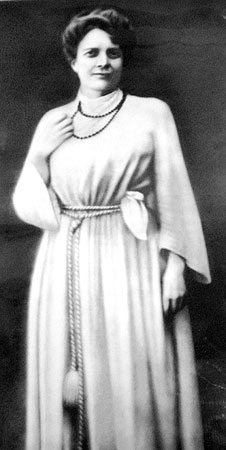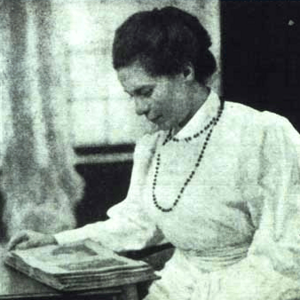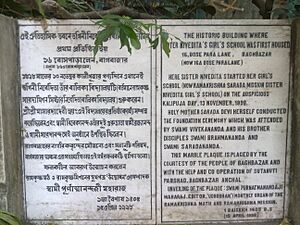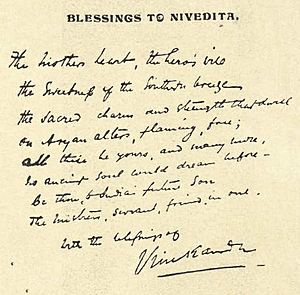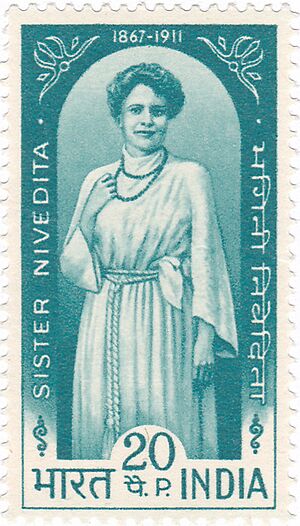Sister Nivedita facts for kids
Quick facts for kids Sister Nivedita |
|
|---|---|

Sister Nivedita in India
|
|
| Birth Date | 28 October 1867 Dungannon, County Tyrone, Northern Ireland, United Kingdom |
| Died on | 13 October 1911 (aged 43) Darjeeling, Bengal Presidency, British India (present-day Darjeeling, West Bengal, India) |
| Birth name | Margaret Elizabeth Noble |
| Guru/teacher | Swami Vivekananda |
| Philosophy | Advaita Vedanta |
Sister Nivedita (born Margaret Elizabeth Noble; 28 October 1867 – 13 October 1911) was an Irish teacher, writer, and social activist. She became a follower of Swami Vivekananda. She spent her early life in Ireland.
In 1895, Sister Nivedita met Swami Vivekananda in London. She then traveled to Calcutta (now Kolkata), India in 1898. Swami Vivekananda gave her the name Nivedita, which means "Dedicated to God". This happened when she took a special vow on 25 March 1898.
In November 1898, she started a school for girls in Calcutta. She wanted to help girls who did not have a chance to get an education. During a serious plague in Calcutta in 1899, Nivedita bravely cared for sick people.
She worked closely with the Ramakrishna Mission. Later, she had to step back from the Mission's public activities. This was because she was involved in the Indian Nationalism movement. The British government in India might have caused problems for the Mission otherwise. She was very close to Sarada Devi, who was the wife of Ramakrishna. She also had strong bonds with Swami Vivekananda's other followers. Sister Nivedita passed away on 13 October 1911 in Darjeeling. Her tombstone says, "Here lies Sister Nivedita who gave her all to India."
Contents
Early Life and Education
Margaret Elizabeth Noble was born on 28 October 1867. Her birthplace was Dungannon in County Tyrone, Ireland. Her parents were Mary Isabel and Samuel Richmond Noble. Her father was a pastor who taught that helping others was like serving God.
When Margaret was young, her father moved to England. Margaret stayed with her grandfather, Hamilton, in Ireland. Her grandfather was a leader in the Irish nationalist movement. From him, Margaret learned to love her country and fight for freedom.
Margaret's father died when she was ten years old. After this, Margaret, her mother, and her siblings returned to Ireland. Margaret's mother became a teacher.
Margaret went to Halifax College. There, the headmistress taught her about making personal sacrifices. She studied many subjects, including science, art, music, and literature.
Becoming a Teacher
At age seventeen in 1884, Margaret began teaching in Keswick. In 1886, she taught at an orphanage in Rugby. A year later, she worked in a coal-mining area in Wrexham in North Wales. Here, she remembered her father's spirit of helping the poor. In Wrexham, she got engaged, but her fiancé sadly passed away soon after.
In 1889, Margaret moved to Chester. She was happy to be reunited with her family in Liverpool.
Margaret continued to study education. She learned from the ideas of Johann Heinrich Pestalozzi and Friedrich Fröbel. These thinkers believed that education should start early. They thought children should learn through play and observation. Margaret became a part of this "New Education" movement in England.
In 1891, Margaret moved to Wimbledon. She helped start a new school in London. In 1892, she opened her own school at Kingsleygate. Her school focused on learning through play, not strict rules. She also learned about art from a teacher named Ebenezer Cooke.
Margaret became a well-known writer and speaker. She met many important people in London. These included famous writers like W.B. Yeats and Bernard Shaw. They often discussed literature, ethics, and politics. In 1892, Margaret spoke strongly in favor of the Home Rule Bill for Ireland.
Her Search for Truth
Margaret grew up learning about Christian beliefs. She was taught to respect all religious teachings. However, as she grew older, she started to have doubts about Christian ideas. She felt they did not always match what she understood as Truth.
For seven years, Margaret felt unsettled and unhappy. She tried to find answers in church service. But her soul was still searching for a deeper truth. This search led her to study natural science.
Meeting Swami Vivekananda
In November 1895, Margaret met Swami Vivekananda in London. He was visiting from America and stayed for three months. Swami Vivekananda was explaining Vedanta philosophy at a gathering. Margaret went with her friend, Ebenezer Cooke. She was very curious.
Margaret described Swami Vivekananda as a "majestic personage" in a saffron robe. He spoke in a deep, powerful voice. Margaret had already studied Eastern teachings. But she was deeply impressed by Swami Vivekananda himself. She attended many of his talks. His answers cleared her doubts and made her respect him greatly.
She also became interested in the teachings of Gautama Buddha. Her talks with Swami Vivekananda brought her much peace. Swami Vivekananda saw her passion and knew she could do great things in India. On 25 March 1898, he dedicated her to God and to serving India. He gave her the name "Nivedita."
Swami Vivekananda had traveled all over India. He saw that education was key to solving India's problems, especially for women. He chose Margaret to help educate Indian women. He wrote to her, "What was wanted was not a man but a woman, a real lioness, to work for the Indians, women especially."
Journey to India
Margaret answered Swami Vivekananda's call and traveled to India. She left her family and friends behind. Her ship, Mombasa, arrived in Calcutta on 28 January 1898. Soon after, she visited Dakshineshwar temple. This was where Ramakrishna, Swami Vivekananda's teacher, had practiced his spiritual path.
Swami Vivekananda spent time teaching her about India. He helped her understand and love the people. He taught her about India's history, philosophy, and traditions. A few weeks later, two other women followers of Swami Vivekananda arrived from America. They were Sara C. Bull and Josephine MacLeod. The three women became lifelong friends.
On 11 March 1898, Swami Vivekananda introduced Sister Nivedita to the people of Calcutta. He said, "England has sent us another gift in Miss Margaret Noble." Margaret told everyone she wanted to serve India. On 17 March, she met Sarada Devi. Sarada Devi lovingly called her Khooki, meaning "little girl."
Becoming Nivedita
On 25 March 1898, Swami Vivekananda formally initiated Margaret. He gave her the vow of Brahmacharya, which means lifelong dedication. He named her "Nivedita," meaning "the dedicated one." He told her to follow the path of serving others.
Swami Vivekananda wanted Nivedita to truly understand Hindu ways of life. He encouraged her to visit Hindu women and observe their customs.
Her Bond with Sarada Devi
Margaret met Sarada Devi on 17 March 1898, soon after arriving in India. Sarada Devi was the wife and spiritual partner of Ramakrishna. Despite language differences, Sarada Devi welcomed her as "khooki" or "little girl." This day was St.Patrick's Day, which was special for Margaret. She called it her "day of days."
Nivedita remained very close to Sarada Devi until her death. On 13 November 1898, Sarada Devi came to open Nivedita's new school. She blessed the school and prayed that the girls would become "ideal girls." Nivedita was very happy. She felt it was a wonderful sign for the future of educated Indian women. The first photograph of Sarada Devi was taken at Nivedita's house.
Nivedita wrote to her friend about Sarada Devi. She said Sarada Devi was "one of the strongest and greatest of women."
Travels and Experiences
Nivedita traveled to many places in India, including Kashmir. She traveled with Swami Vivekananda and her friends, Josephine MacLeod and Sara Bull. These trips helped her connect with Indian people, culture, and history. She also went to the United States to gather support for her work.
On 11 May 1898, she went on a journey to the Himalayas with Swami Vivekananda. From Nainital, they went to Almora. She wrote to her friend, "Oh Nell, Nell, India is indeed the Holy Land." In Almora, she learned how to meditate. She also started learning Bengali.
Later, she traveled to Amarnath with Swami Vivekananda. In 1899, she visited the United States again with him. She wrote about her travels and experiences with Swami Vivekananda in her books. These books include The Master as I Saw Him and Notes on Some Wanderings with Swami Vivekananda. She often called Swami Vivekananda "The King." She saw herself as his spiritual daughter.
Swami Vivekananda's Passing
Sister Nivedita saw Swami Vivekananda for the last time on 2 July 1902. This was at Belur Math. Vivekananda was fasting that day. But he joyfully served food to his followers. After the meal, he poured water over Nivedita's hands and dried them.
Swami Vivekananda died on 4 July 1902. That night, Nivedita dreamed that Ramakrishna was leaving his body again. The next morning, she received a letter from Belur Math. It told her about Vivekananda's death. She rushed to the Math and found his body laid on the floor. She sat by his head and fanned him until his body was moved.
On the afternoon of 5 July, Swami Vivekananda's body was taken for cremation. It was wrapped in a saffron cloth. Nivedita wanted a small piece of the cloth for Josephine MacLeod. A monk offered her a piece. But Nivedita was unsure if it was proper and decided not to take it. As Vivekananda's body was being cremated, she watched the fire. As the fire was dying down, she felt a tug on her sleeve. She turned and found a small piece of saffron cloth. It had somehow come out of the fire. Nivedita took the cloth. She felt it was a message from Swami Vivekananda.
Sister Nivedita's Important Work
Starting a Girls' School
Nivedita wanted to open a school for girls who had no chance to learn. She traveled to England and America. She gave lectures to raise money for her school.
Swami Vivekananda had invited Nivedita to India mainly to spread education among women. He was very excited about her school plan. He organized a meeting to discuss it. Many of Ramakrishna's followers attended. Nivedita explained her school plan. She asked everyone to send their daughters to the school. Swami Vivekananda strongly supported her. He urged everyone to cooperate and send their girls.
On 13 November 1898, on the day of Kali Puja, she opened the school. It was located at 16 Bosepara Lane in the Bagbazar area of North Calcutta. Sarada Devi officially opened the school. Swami Vivekananda and other followers of Ramakrishna were also there. Sarada Devi blessed the school. She prayed that the girls would become "ideal girls."
Nivedita went from house to house to find students. Many girls lived in difficult conditions in early 20th century India. Sometimes, male family members refused to let girls attend. Nivedita also taught widows and adult women. She taught them sewing, hygiene, and nursing, along with regular subjects.
Raising money for the school was hard. She earned money from her writings and lectures. She used all of it to pay for the school. She also worked to improve the lives of Indian women from all backgrounds.
Helping During the Plague
In 1899, a plague epidemic broke out in Calcutta. Nivedita bravely nursed the sick. She helped clean the affected areas. She inspired many young people to volunteer. She asked for financial help in newspapers. She organized the relief work. She personally gave instructions on how to prevent the disease.
She was friends with many important Indian thinkers and artists. These included Rabindranath Tagore, Jagadish Chandra Bose, and Abanindranath Tagore. She later became involved in the Indian independence movement. Sri Aurobindo was also her friend.
Promoting Indian Culture
Nivedita actively promoted Indian history, culture, and science. She strongly encouraged Dr. Jagadish Chandra Bose, a famous Indian scientist. She helped him financially. She also helped him get recognition when the British government was not supportive. Rabindranath Tagore said that Nivedita was an "invaluable energizer and helper" for Jagadish Chandra Bose. She edited his writings and made sure his work was shared.
Because she was Western-born but a follower of Swami Vivekananda, she could do things that might have been hard for Indians. For example, she helped promote a sense of unity across India.
Supporting Indian Nationalism
Nivedita became a well-known writer and speaker. She traveled across India giving talks. She spoke about Indian culture and religions. She urged young Indians to work for their country, following Swami Vivekananda's ideals. Before coming to India, Nivedita thought British rule was good. But after living in India, she realized that India needed independence to thrive. In February 1902, Mohandas Karamchand Gandhi visited Nivedita in Calcutta.
After Vivekananda's death, Nivedita publicly separated herself from the Ramakrishna Mission. This was to protect the Mission from problems due to her political activities. However, she remained close to Swami Vivekananda's other followers and Sarada Devi. They helped her with her charity and education work.
She worked with young revolutionaries in Bengal. She inspired many young people to join the independence movement through her speeches. She also criticized Lord Curzon, a British official. He had said that Westerners valued truth more than Easterners. Nivedita found proof that Curzon himself had lied. This was published in newspapers and forced Curzon to apologize.
In 1905, the British government divided Bengal. This was a major event in the independence movement. Nivedita played a key role in organizing protests. She provided money and support. She also used her contacts to get information and warn activists.
She inspired Indian artists like Abanindranath Tagore to create art in a pure Indian style. She guided talented students to explore ancient Indian art. She greatly influenced the Tamil poet, Subramania Bharati. She encouraged him to work for women's freedom in India.
Nivedita even designed a national flag for India. It had a thunderbolt symbol on a red background. She tried to teach her students about nationalism in their daily activities. She introduced the singing of the song Vande Mataram as a prayer in her school. She also supported Annie Besant and was close to Aurobindo Ghosh, a leader in the early nationalist movement. She edited his nationalist newspaper, Karma Yogin.
Her Passing
Nivedita died on 13 October 1911, at the age of 43. She passed away at Roy Villa, Darjeeling. Her memorial is located near the Railway station in Darjeeling. Her epitaph reads: "Here lies Sister Nivedita who gave her all to India." Swami Vivekananda wrote a poem for her, A benediction to Sister Nivedita. In it, he called her "The mistress, servant, friend in one to India's future son."
Her Legacy
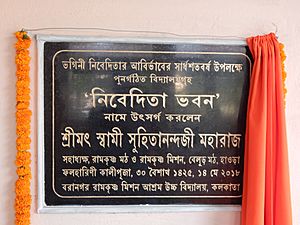
Sister Nivedita is still one of the most important women in India's history. Her book Kali, the Mother inspired Abanindranath Tagore to paint Bharat Mata. In 2010, an office in Kolkata was named after her. The Sister Nivedita Academy in Chennai is dedicated to her memory. Many schools and colleges are named after her.
In 1968, the Indian Government released a postal stamp in her honor. The Nivedita bridge near Dakshineswar, Kolkata, is also named after her. In 2015, a new college in Kolkata was named Sister Nivedita Government Degree College. In 2018, a school building at Baranagore Ramakrishna Mission Ashrama High School was named "Nivedita Bhawan."
Her Books
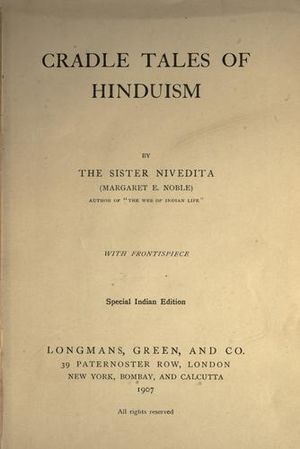
Sister Nivedita wrote many books. The Web of Indian Life helped correct misunderstandings about Indian culture in the West. Kali the Mother was another important work. She wrote about Swami Vivekananda in The Master as I Saw Him and Notes of Some Wanderings with the Swami Vivekananda. Her book Cradle Tales of Hinduism shared stories from ancient Indian texts like the Puranas, Ramayana, and Mahabharata. Other works include Studies from an Eastern Home and Footfalls of Indian History.
About Her Life
Many books have been written about Sister Nivedita. In 1952, the Ramakrishna Mission Sister Nivedita Girls' School decided to publish her biography. They wanted to make sure the facts were correct. Pravrajika Muktiprana wrote a detailed account of her life in Bengali in 1959. Later, an English version was published in 1961 as Sister Nivedita of Ramakrishna-Vivekananda. These books used Nivedita's own writings, letters, and interviews with people who knew her.
Her letters were published in two volumes in 1960. There were over 800 letters. They show her thoughts and feelings. In 1975, Barbara Fox wrote Long Journey Home, which looked at Nivedita's work from an English woman's view.
See also
 In Spanish: Sister Nivedita para niños
In Spanish: Sister Nivedita para niños


